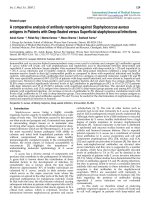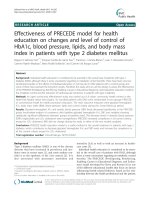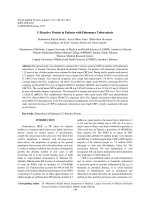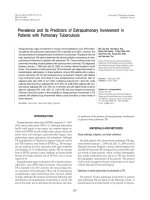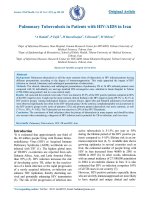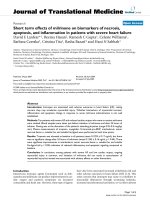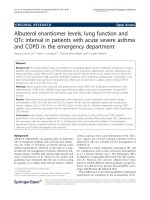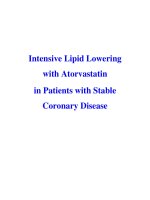Endarterectomy versus Stenting in Patients with Symptomatic Severe Carotid Stenosis pptx
Bạn đang xem bản rút gọn của tài liệu. Xem và tải ngay bản đầy đủ của tài liệu tại đây (210.42 KB, 13 trang )
Endarterectomy versus
Stenting in Patients with
Symptomatic Severe Carotid
Stenosis
original article
The
new england journal of medicine
1660
Endarterectomy versus Stenting in Patients
with Symptomatic Severe Carotid Stenosis
Jean-Louis Mas, M.D., Gilles Chatellier, M.D., Bernard Beyssen, M.D.,
Alain Branchereau, M.D., Thierry Moulin, M.D., Jean-Pierre Becquemin, M.D.,
Vincent Larrue, M.D., Michel Lièvre, M.D., Didier Leys, M.D., Ph.D.,
Jean-François Bonneville, M.D., Jacques Watelet, M.D.,
Jean-Pierre Pruvo, M.D., Ph.D., Jean-François Albucher, M.D.,
Alain Viguier, M.D., Philippe Piquet, M.D., Pierre Garnier, M.D.,
Fausto Viader, M.D., Emmanuel Touzé, M.D., Maurice Giroud, M.D.,
Hassan Hosseini, M.D., Ph.D., Jean-Christophe Pillet, M.D.,
Pascal Favrole, M.D., Jean-Philippe Neau, M.D., and Xavier Ducrocq, M.D.,
for the EVA-3S Investigators*
From Hôpitaux Sainte-Anne (J L.M., B.B.,
E.T.) and Europeén Georges Pompidou
(G.C.), Université René Descartes, Paris;
Hôpitaux La Timone (A.B.) and Sainte-
Marguerite (P.P.), Université de la Médi-
terranée, Marseille; Hôpital Jean Minjoz,
Université de Franche-Comté, Besançon
(T.M., J F.B.); Hôpital Henri Mondor,
Université Paris-Val-de-Marne, Créteil
(J P.B., H.H.); Hôpitaux Rangueil (V.L.,
A.V.) and Purpan (J F.A.), Université Paul
Sabatier, Toulouse; Université Claude Ber-
nard, Lyon (M.L.); Hôpital Roger Salen-
gro, Université du Droit et de la Santé,
Lille (D.L., J P.P.); Hôpital Charles Nicolle,
Université de Rouen, Rouen (J.W.); Hôpi-
tal de Bellevue, Université Jean Monnet,
Saint-Etienne (P.G.); Hôpital Côte de Na-
cre, Université de Caen, Caen (F.V.); Hôpi-
tal Général, Université de Bourgogne,
Dijon (M.G.); Nouvelles Cliniques Nan-
taises, Nantes (J C.P.); Hôpital Lari-
boisière, Université Denis Diderot, Paris
(P.F.); Hôpital La Milétrie, Université de
Poitiers, Poitiers (J P.N.); and Hôpital
Saint-Julien Université Henri Poincaré,
Nancy (X.D.) — all in France. Address
reprint requests to Dr. Mas at the Service
de Neurologie, Hôpital Sainte-Anne, 1 Rue
Cabanis, 75674 Paris CEDEX 14, France,
or at
*
Investigators and committees of the
Endarterectomy versus Angioplasty
in Patients with Symptomatic Severe
Carotid Stenosis (EVA-3S) trial are
listed in
the Appendix.
N Engl J Med 2006;355:1660-71.
Copyright © 2006 Massachusetts Medical Society.
ABSTRACT
Background
Carotid stenting is less invasive than endarterectomy, but it is unclear whether it is as
safe in patients with symptomatic carotid-artery stenosis.
Methods
We conducted a multicenter, randomized, noninferiority trial to compare stenting
with endarterectomy in patients with a symptomatic carotid stenosis of at least 60%.
The primary end point was the incidence of any stroke or death within 30 days after
treatment.
Results
The trial was stopped prematurely after the inclusion of 527 patients for reasons of
both safety and futility. The 30-day incidence of any stroke or death was 3.9% after
endarterectomy (95% confidence interval [CI], 2.0 to 7.2) and 9.6% after stenting
(95% CI, 6.4 to 14.0); the relative risk of any stroke or death after stenting as com-
pared with endarterectomy was 2.5 (95% CI, 1.2 to 5.1). The 30-day incidence of dis-
abling stroke or death was 1.5% after endarterectomy (95% CI, 0.5 to 4.2) and 3.4%
after stenting (95% CI, 1.7 to 6.7); the relative risk was 2.2 (95% CI, 0.7 to 7.2). At
6 months, the incidence of any stroke or death was 6.1% after endarterectomy and
11.7% after stenting (P = 0.02). There were more major local complications after stent-
ing and more systemic complications (mainly pulmonary) after endarterectomy, but
the differences were not significant. Cranial-nerve injury was more common after
endarterectomy than after stenting.
Conclusions
In this study of patients with symptomatic carotid stenosis of 60% or more, the rates
of death and stroke at 1 and 6 months were lower with endarterectomy than with
stenting. (ClinicalTrials.gov number, NCT00190398.)
n engl j med 355;16 www.nejm.org october 19, 2006
Copyright © 2006 Massachusetts Medical Society. All rights reserved.
Downloaded from www.nejm.org at RIKSHOSPITALET HF on February 18, 2008 .
endarterectomy versus stenting in severe carotid stenosis
n engl j med 355;16 www.nejm.org october 19, 2006
1661
F
indings from two large randomized,
clinical trials
1-3
have established endarterec-
tomy as the standard treatment for severe
symptomatic carotid-artery stenosis. As compared
with endarterectomy, stenting avoids the need for
general anesthesia and an incision in the neck that
could lead to nerve injury and wound complica-
tions. The costs may be less than those of surgery,
mainly because the hospital stay is shorter. How-
ever, stenting also carries a risk of stroke and local
complications, and the long-term efficacy of this
technique is not well known. A systematic review
4
of five randomized trials comparing stenting with
endarterectomy
5-10
concluded that the current evi-
dence does not support a change from the recom-
mendation of carotid endarterectomy as the stan-
dard treatment for carotid stenosis. Several more
trials are in progress in Europe
11-13
and the United
States.
14
We conducted this trial, which started in No-
vember 2000, to evaluate whether stenting is not
inferior to endarterectomy with regard to the
risks of the procedure and its long-term efficacy
in patients with symptomatic carotid stenosis.
In September 2005, the safety committee recom-
mended that enrollment in the trial be stopped.
We report on the risks of stroke or death within
30 days and 6 months after treatment.
Methods
The Endarterectomy versus Angioplasty in Patients
with Symptomatic Severe Carotid Stenosis (EVA-3S)
trial, a publicly funded, randomized, noninferiority
trial, was conducted in 20 academic and 10 non-
academic centers in France. The study was ap-
proved by the ethics committee of Hôpital Cochin
in Paris. All patients provided written informed
consent.
Centers and Investigators
To join the trial, each center was required to as-
semble a team of physicians comprising at least one
neurologist, one vascular surgeon, and one inter-
ventional physician. The neurologist was respon-
sible for the initial evaluation and follow-up of the
patients. The vascular surgeon had to have per-
formed at least 25 endarterectomies in the year
before enrollment. The interventional physician
had to have performed at least 12 carotid-stenting
procedures or at least 35 stenting procedures in
the supraaortic trunks, of which at least 5 were in
the carotid artery. Centers fulfilling all require-
ments except those with regard to the interven-
tional physician could join the EVA-3S study and
randomly assign patients, but all stenting proce-
dures had to be performed under the supervision
of an experienced tutor (a clinician who qualified
to perform stenting in this study) until the local
interventional physician became self-sufficient (ac-
cording to the tutor) and performed a sufficient
number of procedures according to the predefined
criteria.
Patients
Patients were eligible if they were 18 years of age
or older, had had a hemispheric or retinal transient
ischemic attack or a nondisabling stroke (or reti-
nal infarct) within 120 days before enrollment, and
had a stenosis of 60 to 99% in the symptomatic
carotid artery, as determined by the North Amer-
ican Symptomatic Carotid Endarterectomy Trial
(NASCET) method.
15
The degree of stenosis war-
ranting treatment, set at 70% or more at the start of
the trial, was subsequently (in October 2003) set at
60% or more because endarterectomy was shown
to benefit patients with symptomatic stenosis of
50 to 69%.
3
The presence of an ipsilateral carotid
stenosis of 60% or more had to be conf irmed by
means of catheter angiography or both duplex
scanning and magnetic resonance angiography
of the carotid artery.
Patients were excluded if one of the following
was present: a modified Rankin score
16
of 3 or
more (disabling stroke) (on a scale of 0 to 5, with
higher scores indicating more severe disability);
nonatherosclerotic carotid disease; severe tan-
dem lesions (stenosis of proximal common carotid
artery or intracranial artery that was more severe
than the cervical lesion); previous revasculariza-
tion of the symptomatic stenosis; history of bleed-
ing disorder; uncontrolled hypertension or diabe-
tes; unstable angina; contraindication to heparin,
ticlopidine, or clopidogrel; life expectancy of less
than 2 years; or percutaneous or surgical interven-
tion within 30 days before or after the study pro-
cedure. The appearance of the stenotic lesion on
angiography was not a factor in the selection of
patients.
Patients who were suitable candidates for both
techniques were randomly assigned to undergo
endarterectomy or stenting. Randomization was
carried out centrally by means of a computer-gen-
erated sequence, involving randomized blocks of
Copyright © 2006 Massachusetts Medical Society. All rights reserved.
Downloaded from www.nejm.org at RIKSHOSPITALET HF on February 18, 2008 .
The new england journal of medicine
n engl j med 355;16 www.nejm.org october 19, 2006
1662
two, four, or six patients that were stratified accord-
ing to study center and degree of stenosis (steno-
sis of ≥90% or <90%).
Endarterectomy and Stenting
The goal was for endarterectomy and stenting to
be performed within 2 weeks after randomization.
Surgeons performed endarterectomy according to
customary practice. Carotid stenting had to be car-
ried out through the femoral route with the use of
stents and protection devices approved by the ac-
creditation committee. Interventional physicians
had to have performed at least two stenting pro-
cedures with any new device before its use in the
trial. In January 2003, the safety committee recom-
mended the systematic use of stents with cerebral
protection devices because of a higher risk of stroke
in patients treated without cerebral protection
17
;
centers began using them on February 1, 2003. The
daily use of aspirin (100 to 300 mg) and clopido-
grel (75 mg) or ticlopidine (500 mg) for 3 days be-
fore and 30 days after stenting was also recom-
mended.
Follow-up and End Points
The study neurologists performed follow-up eval-
uations at 48 hours, 30 days, 6 months after treat-
ment, and every 6 months thereafter. The primary
end point was a composite of any stroke or death
occurring within 30 days after treatment. Second-
ary outcomes were myocardial infarction, transient
ischemic attack, cranial-nerve injury, major local
complications, and systemic complications with-
in 30 days after treatment; and composites of any
stroke or death within 30 days after treatment plus
ipsilateral stroke, any stroke, or any stroke or death
within 31 days through the end of follow-up. Neu-
rologists assessed the degree of disability from
stroke 30 days and 6 months after the event. Func-
tional disability from cranial-nerve injury was cat-
egorized as absent, mild, moderate, or severe at the
30-day follow-up visit. Neurologists also recorded
whether treatment-related outcomes were associ-
ated with a delay in discharge. The occurrence of
stroke, death, and other outcomes was assessed by
the events committee, which was unaware of the
treatment assignments (except for patients who
had local complications).
Statistical Analysis
We calculated
18
that we would need to enroll 872
patients for the study to have a statistical power
of 80% to assess whether stenting was not infe-
rior to endarterectomy with regard to the 30-day
incidence of stroke or death, given an expected
30-day incidence of stroke or death of 5.6% af-
ter endarterectomy
19
and 4% after stenting,
20,21
a true absolute difference between groups in
the 30-day risk of stroke or death of no more
than 2% (noninferiority margin), and a one-
sided alpha of 0.05. A similar difference in the
30-day risk of stroke or death between endarter-
ectomy and medical treatment was observed in
NASCET.
22
Our protocol required that an inde-
pendent safety committee review safety issues
each time 10 new validated primary outcome
events occurred, with no predetermined rule for
stopping the trial, and reassess the number of
patients required to show an effect after 30 pri-
mary outcome events had occurred. In Septem-
ber 2005, the safety committee recommended
stopping enrollment for reasons of both safety
and futility. On the basis of the observed 30-day
risk of stroke or death after endarterectomy, we
would have needed to enroll more than 4000
patients to test the noninferiority of stenting
(assuming that the relative noninferiority limit
was unchanged). Given the observed 30-day
risks of stenting, the committee considered it to
be extremely unlikely that the trial, should it
continue with more patients, would reach its
objectives.
Analyses of the 30-day outcomes were based on
all patients who were randomly assigned to treat-
ment and who underwent carotid repair. The re-
sults are presented as relative risks with 95% con-
fidence intervals (CIs), calculated with the use of
superiority analysis. We also assessed noninferior-
ity, as initially planned. We assessed homogeneity
of the relative risks of stroke or death among cen-
ters using the Breslow–Day test. For this purpose,
centers were categorized into three groups, ac-
cording to the numbers of patients included in the
study (<21, 21 to 40, and >40 patients). Analyses of
the 6-month outcomes were based on all patients
who were randomly assigned to treatment. Rates
of stroke and death were estimated with the use
of the Kaplan–Meier method. All data were ana-
lyzed according to the intention-to-treat principle.
All P values are two-sided and were not adjusted
for multiple testing. We used SAS software (version
8.2) for all analyses. The authors vouch for the
completeness and veracity of the data and data
analyses.
Copyright © 2006 Massachusetts Medical Society. All rights reserved.
Downloaded from www.nejm.org at RIKSHOSPITALET HF on February 18, 2008 .
endarterectomy versus stenting in severe carotid stenosis
n engl j med 355;16 www.nejm.org october 19, 2006
1663
Results
Patients and Treatments
By September 2005, 527 patients had been random-
ly assigned to treatment, 7 of whom did not un-
dergo carotid repair (Fig. 1). The remaining 520
patients were included in the analysis of the 30-day
risk of stroke or death. Three strokes that occurred
between randomization and treatment were not
included in the analysis of the 30-day risk of stroke
or death but were included in the 6-month analy-
sis of outcomes. The two groups were similar with
respect to baseline characteristics, except for a
greater proportion of patients 75 years of age or
older and more patients with a history of stroke
in the endarterectomy group and a higher propor-
tion of contralateral carotid occlusion in the stent-
ing group (
Table 1
).
Characteristics of the endarterectomy and stent-
ing procedures are listed in Table 2. Two patients
underwent a repeated procedure within 48 hours
after the initial endarterectomy owing to residu-
al stenosis or dissection. In 13 patients, stenting
was converted intraoperatively to endarterectomy
owing to problems with access. Two of these pa-
tients had a stroke before endarterectomy.
End Points
Although the trial was intended to assess noninfe-
riority, we observed that stenting carried a greater
risk than did endarterectomy. When we analyzed
the data as planned, the 95% CI of the difference
in the 30-day incidence of stroke or death between
stenting and endarterectomy (2.1 to 9.3%) did not
include the 2% limit used to define noninferior-
ity. The 30-day incidence of any stroke or death was
3.9% (95% CI, 2.0 to 7.2) after endarterectomy and
9.6% (95% CI, 6.4 to 14.0) after stenting, with a
relative risk of 2.5 (95% CI, 1.2 to 5.1). The abso-
lute risk increase was 5.7%, suggesting that one
additional stroke or death resulted when 17 pa-
tients underwent stenting rather than endarter-
ectomy. The 30-day incidence of disabling stroke
or death was 1.5% (95% CI, 0.5 to 4.2) after end-
arterectomy and 3.4% (95% CI, 1.7 to 6.7) after
stenting, resulting in a relative risk of 2.2 (95%
CI, 0.7 to 7.2) (
Table 3
). A greater proportion of
strokes occurred on the day of the procedure in
the stenting group than in the endarterectomy
group (17 of 24 vs. 3 of 9, P = 0.05).
The relative risk of stroke or death did not dif-
fer significantly among the centers that enrolled
fewer than 21 patients (relative risk, 1.9; 95% CI, 0.6
to 6.2), those that enrolled 21 to 40 patients (rela-
tive risk, 3.3; 95% CI, 0.7 to 15.2), and those that
enrolled more than 40 patients (relative risk, 2.7;
95% CI, 0.9 to 8.1) (P = 0.83). The 30-day incidence
of stroke or death was similar among patients
treated by interventional physicians who were
experienced (11 of 105, or 10.5%), tutored during
training (7 of 98, or 7.1%), and tutored after train-
ing (7 of 57, or 12.3%) (P = 0.54; chi-square sta-
tistic, 1.25).
527 Patients underwent
randomization
262 Assigned to
endarterectomy
3 Did not undergo endarterectomy
1 Declined
1 Had carotid occlusion
1 Had a stroke before treatment
259 Underwent carotid repair and
were included in analysis of
the primary outcome
2 Had a TIA between randomi-
zation and endarterectomy
2 Underwent stenting
265 Assigned to stenting
4 Did not undergo stenting
1 Declined
2 Had <60% stenosis
1 Had a stroke before treatment
261 Underwent carotid repair and
were included in analysis of
the primary outcome
1 Had a nondisabling stroke
1 Had a TIA and 1 had a myo-
cardial infarction between
randomization and stenting
1 Underwent endarterectomy
Endarterectomy attempted
in 257
Stenting attempted
in 260
Endarterectomy completed
in 257
Stenting failed in 13, who then
underwent endarterectomy
Stenting completed in 247
Figure 1. Randomization and Treatment.
Carotid repair was successful in the five patients who had a transient is che-
mic attack (TIA), a nondisabling stroke, or myocardial infarction between
randomization and carotid repair. The three strokes occurred within 2 days
after randomization.
Copyright © 2006 Massachusetts Medical Society. All rights reserved.
Downloaded from www.nejm.org at RIKSHOSPITALET HF on February 18, 2008 .
The new england journal of medicine
n engl j med 355;16 www.nejm.org october 19, 2006
1664
The 30-day incidence of stroke or death was
lower among patients who underwent stenting
with cerebral protection (18 of 227, or 7.9%) than
among those treated with stenting alone (5 of 20,
or 25%; P = 0.03). However, the relative risk of stroke
or death for stenting over endarterectomy did not
differ significantly before systematic use of a ce-
rebral protection device was recommended (2.0;
95% CI, 0.8 to 5.0) or after (3.4; 95% CI, 1.1 to
10.0; P = 0.50).
Table 1. Baseline Characteristics of the Patients.*
Characteristic
Endarterectomy
Group
(N = 259)
Stenting Group
(N = 261) P Value
Age — yr 70.3±10.7 69.1±10.2 0.21
Age ≥75 yr — no. of patients (%) 105 (40.5) 84 (32.2) 0.06
Male sex — no. of patients (%) 202 (78.0) 189 (72.4) 0.16
Vascular risk factors
Hypertension — no. of patients (%)† 188 (72.6) 192 (73.6) 0.84
Diabetes — no. of patients (%)† 66 (25.5) 58 (22.2) 0.41
Hypercholesterolemia — no. of patients (%)† 144 (55.6) 151 (57.9) 0.66
Tobacco use — no. of patients (%)‡ 61 (23.6) 63 (24.1) 0.92
Systolic blood pressure — mm Hg 140.8±17.8 140.9±16.5 0.95
Diastolic blood pressure — mm Hg 77.1±10.8 77.8±9.9 0.42
Body-mass index§ 26.3±4.1 26.1±4.6 0.63
History of vascular disease — no. of patients (%)
Stroke 52 (20.1) 33 (12.6) 0.02
Transient ischemic attack 60 (23.2) 66 (25.3) 0.61
Myocardial infarction 34 (13.1) 28 (10.7) 0.42
Peripheral arterial disease 30 (11.6) 37 (14.2) 0.43
Cardiac failure leading to hospitalization 7 (2.7) 7 (2.7) 1.00
Prior surgery or angioplasty — no. of patients (%)
Coronary artery 34 (13.1) 35 (13.4) 1.00
Carotid artery 10 (3.9) 5 (1.9) 0.20
Other artery 23 (8.9) 16 (6.1) 0.25
Medications before qualifying event — no. of patients (%)
Antiplatelet therapy 136 (52.5) 128 (49.0) 0.43
Antihypertensive medication 177 (68.3) 179 (68.6) 1.00
Antidiabetic agents 64 (24.7) 53 (20.3) 0.25
Lipid-lowering medication 125 (48.3) 129 (49.4) 0.79
Qualifying event — no. of patients (%) 0.47
Cerebral transient ischemic attack 78 (30.1) 95 (36.4)
Ocular transient ischemic attack 37 (14.3) 33 (12.6)
Ischemic stroke 139 (53.7) 127 (48.7)
Retinal infarct 5 (1.9) 6 (2.3)
Modified Rankin score at randomization¶ 0.94
0 145 (56.0) 139 (53.3)
1 68 (26.3) 71 (27.2)
2 42 (16.2) 47 (18.0)
3 4 (1.5) 4 (1.5)
Copyright © 2006 Massachusetts Medical Society. All rights reserved.
Downloaded from www.nejm.org at RIKSHOSPITALET HF on February 18, 2008 .
endarterectomy versus stenting in severe carotid stenosis
n engl j med 355;16 www.nejm.org october 19, 2006
1665
The relative risk of stroke or death adjusted for
age was 2.4 (95% CI, 1.2 to 4.8) and adjusted for
the presence or absence of a history of stroke was
2.6 (95% CI, 1.3 to 5.2). More patients in the stent-
ing group had contralateral carotid occlusion; none
of them had a stroke after stenting. The 30-day
incidence of stroke or death after stenting did not
differ significantly between patients who received
dual antiplatelet therapy (19 of 211, or 9.0%) and
those who received single antiplatelet therapy (4 of
36, or 11.1%; P = 0.75).
There were more systemic complications (main-
ly pulmonary) after endarterectomy and more se-
vere local complications after stenting than after
endarterectomy, but these differences were not
significant. Cranial-nerve injury was significantly
more common after endarterectomy than after
stenting (7.7% vs. 1.1%, P<0.001). The median
duration of the hospital stay was shorter after
stenting (3 days; interquartile range, 2 to 5) than
after endarterectomy (4 days; interquartile range,
3 to 5; P = 0.01).
Table 1. (Continued.)
Characteristic
Endarterectomy
Group
(N = 259)
Stenting Group
(N = 261) P Value
Brain imaging — no. of patients (%)
Computed tomography 217 (83.8) 230 (88.1) 0.17
Magnetic resonance imaging 161 (62.2) 156 (59.8) 0.59
Infarct corresponding to the qualifying event 133 (51.4) 117 (44.8) 0.16
Previous infarct 70 (27.0) 68 (26.1) 0.84
Diagnostic carotid angiography — no. of patients (%)
Catheter angiography 110 (42.5) 113 (43.3) 0.86
Magnetic resonance angiography 163 (62.9) 161 (61.7) 0.79
Ultrasonography 245 (94.6) 253 (96.9) 0.20
Degree of symptomatic carotid stenosis — no. of patients (%)∥ 0.68
60–69% 21 (8.1) 15 (5.7)
70–79% 55 (21.2) 56 (21.5)
80–89% 77 (29.7) 86 (33.0)
90–99% 106 (40.9) 104 (39.8)
Contralateral carotid occlusion — no. of patients (%) 3 (1.2) 13 (5.0) 0.02
Contralateral stenosis of 60–99% — no. of patients (%) 44 (17.0) 31 (11.9) 0.11
Time from qualifying event to treatment — no. of patients (%) 0.62
<2 wk 41 (15.8) 53 (20.3)
2–4 wk 68 (26.3) 66 (25.3)
4–12 wk 124 (47.9) 118 (45.2)
>12 wk 26 (10.0) 24 (9.2)
Time from randomization to treatment
Median — days 6.0 6.0 0.52
Interquartile range — days 2–10 3–9
<2 wk — no. of patients (%) 240 (92.7) 249 (95.4) 0.26
* Plus–minus values are means ±SD. Proportions, means, and medians were compared with the use of Fisher’s exact
test, Student’s t-test, and the Wilcoxon nonparametric test, respectively.
† This condition was diagnosed before the qualifying event.
‡ Tobacco use was defined as the smoking of one cigarette or more per day.
§ The body-mass index is the weight in kilograms divided by the square of the height in meters.
¶ The modified Rankin score ranges from 0 to 5, with higher scores indicating more severe disability.
∥ The degree of stenosis was measured with the use of digital subtraction angiography or magnetic resonance angiogra-
phy, according to the NASCET method.
Copyright © 2006 Massachusetts Medical Society. All rights reserved.
Downloaded from www.nejm.org at RIKSHOSPITALET HF on February 18, 2008 .
The new england journal of medicine
n engl j med 355;16 www.nejm.org october 19, 2006
1666
Table 2. Characteristics of Treatment for 257 Patients Who Completed Endarterectomy and 247 Patients Who
Completed Stenting.*
Treatment Group Value
Endarterectomy
Anesthesia — no. of patients (%)†
General 187 (73.0)
Locoregional 69 (27.0)
Cerebral monitoring — no. of patients (%)† 66 (25.8)
Surgical technique — no. of patients (%)
Endarterectomy
With the use of a patch 129 (50.2)
Without the use of a patch 53 (20.6)
Eversion 63 (24.5)
Carotid–carotid bypass 11 (4.3)
Transposition 1 (0.4)
Shunt 50 (19.5)
Duration of surgery — min
Median 80
Interquartile range 60–110
Medical treatment — no. of patients (%)
Preprocedure‡
Antiplatelet therapy 168 (69.1)
Anticoagulant therapy 30 (12.3)
Both 45 (18.5)
During procedure§
Heparin 253 (99.2)
Postprocedure¶
Antiplatelet therapy 97 (38.2)
Anticoagulant therapy∥ 16 (6.3)
Both 141 (55.5)
Stenting
Anesthesia — no. of patients (%)
General 16 (6.5)
Neuroleptanalgesia 56 (22.7)
Local 175 (70.9)
Mean length of lesion— mm 15.6±7.9
Femoral route — no. of patients (%) 238 (96.4)
Predilatation of stenosis — no. of patients (%) 42 (17.0)
Number of stents — no. of patients (%)
0 1 (0.4)
1 236 (95.5)
2 or more 10 (4.0)
Stent across external carotid artery — no. of patients (%)** 202 (82.1)
Copyright © 2006 Massachusetts Medical Society. All rights reserved.
Downloaded from www.nejm.org at RIKSHOSPITALET HF on February 18, 2008 .
endarterectomy versus stenting in severe carotid stenosis
n engl j med 355;16 www.nejm.org october 19, 2006
1667
Table 2. (Continued.)
Treatment Group Value
Stenting
Duration of procedure (min)
Median 70
Interquartile range 50–90
Type of stent used — no. of patients (%)**
Carotid Wallstent Monorail (Boston Scientific) 140 (56.9)
Acculink (Abbott) 70 (28.5)
Precise RX (Cordis) 26 (10.6)
Carotid Wallstent OTW (Boston Scientific) 5 (2.0)
Zilver (Cook) 5 (2.0)
Cerebral protection — no. of patients (%) 227 (91.9)
Before systematic use of protection devices recommended
by safety committee
58 (78.4)††
After systematic use of protection devices recommended
by safety committee
169 (97.7)††
Device used
GuardWire Plus (Medtronic) 67 (29.5)
FilterWire EZ (Boston Scientific) 61 (26.9)
Spider RX (ev3) 30 (13.2)
EmboShield (Abbott) 24 (10.6)
Angioguard RX (Cordis) 21 (9.3)
Spider (ev3) 19 (8.4)
Accunet (Abbott) 5 (2.2)
Medical treatment — no. of patients (%)
Preprocedure†
Dual antiplatelet therapy 204 (82.9)
Single antiplatelet therapy 42 (17.1)
During procedure
Heparin 241 (97.6)
Atropine 192 (77.7)
Postprocedure
Dual antiplatelet therapy 211 (85.4)
Single antiplatelet therapy 36 (14.6)
* Plus–minus values are means ±SD. Percentages may not total 100 because of rounding.
† Data are missing for one patient.
‡ Data are missing for 14 patients.
§ Data are missing for two patients.
¶ Data are missing for three patients.
∥ Anticoagulant therapy consisted of low-molecular-weight heparins at prophylactic doses for a few days.
** The stent could not be implanted in one patient.
†† Among the 247 patients who completed stenting, 74 underwent stenting before the recommendation was given and
173 underwent stenting afterward.
Copyright © 2006 Massachusetts Medical Society. All rights reserved.
Downloaded from www.nejm.org at RIKSHOSPITALET HF on February 18, 2008 .
The new england journal of medicine
n engl j med 355;16 www.nejm.org october 19, 2006
1668
Table 4
lists the incidence of primary outcome
events at 6 months. The three composite outcomes
were significantly more common after stenting
than after endarterectomy.
Discussion
This trial was stopped early for reasons of both
safety and futility. The 30-day risk of any stroke
or death was significantly higher after stenting
(9.6%) than after endarterectomy (3.9%), resulting
in a relative risk of 2.5 (95% CI, 1.2 to 5.1). Al-
though early stopping of randomized clinical tri-
als carries a risk of the overestimation of treat-
ment effects (i.e., analyzing the data at a “random
high”),
23
the excess of primary outcome events af-
ter stenting was considered large enough (one ad-
ditional stroke or death among each 17 patients
treated by stenting) for the safety committee to rec-
ommend stopping the trial. In addition, the ob-
served rates of the primary outcome made it very
unlikely that the trial would show the noninferior-
ity of stenting.
The 30-day incidence of stroke or death after
endarterectomy was lower in our trial than in pre-
vious trials of endarterectomy in symptomatic pa-
tients.
1,2
The lower surgical risk in our study is
unlikely to be explained by the selection of sur-
geons with a very high level of expertise. Indeed,
the surgeons worked in academic and nonaca-
demic centers in various areas of France and had
only to have performed 25 endarterectomies in
the year before enrollment; there was no upper
limit for perioperative stroke and death. The base-
line characteristics of our patients were similar
to those included in other trials of endarterec-
tomy,
2,5
which makes it unlikely that our find-
ings are explained by the inclusion of patients at
low risk for perioperative stroke or death. More-
over, to prevent the underreporting of minor
strokes in patients who underwent surgery un-
der general anesthesia and then were returned to
surgical wards, all patients were examined 2 days
after the procedure. Therefore, the most likely
explanation for the low rate of complications
from endarterectomy in our trial is that the risks
of this procedure have decreased since the piv-
otal trials
1,2
were conducted.
The combination of results of previous trials
4
yielded a 30-day incidence of stroke or death after
endovascular repair of the carotid artery of 8.1%
(51 of 632 patients; range, 0.0 to 12.1%). There
was significant heterogeneity among these trials,
which may have resulted from the use of differ-
Table 3. Risk of Stroke or Death and Other Treatment-Related Outcomes within 30 Days after Endarterectomy
or Stenting.*
Outcome Event
Endarterectomy
(N = 259)
Stenting
(N = 261)
Unadjusted
Relative Risk
(95% CI) P Value
no. of patients (%)
Nonfatal stroke 7 (2.7)† 23 (8.8)‡ 3.3 (1.4–7.5) 0.004
Symptoms lasting 7 days or more 6 (2.3) 20 (7.7)
Nondisabling 6 (2.3) 16 (6.1)
Disabling§ 1 (0.4) 7 (2.7)
Death 3 (1.2) 2 (0.8) 0.7 (0.1–3.9) 0.68
Fatal stroke 2 (0.8)† 1 (0.4)‡
Other cause 1 (0.4)¶ 1 (0.4)∥
Any stroke or death 10 (3.9) 25 (9.6) 2.5 (1.2–5.1) 0.01
Any disabling stroke or death 4 (1.5) 9 (3.4) 2.2 (0.7–7.2) 0.26
Transient ischemic attack 2 (0.8) 6 (2.3) 3.0 (0.6–14.6) 0.28
Myocardial infarction** 2 (0.8) 1 (0.4) 0.5 (0.04–5.4) 0.62
Bradycardia or hypotension†† 0 11 (4.2) Not computable <0.001
Systemic complications 8 (3.1)‡‡ 5 (1.9)§§ 0.6 (0.2–1.9) 0.42
Copyright © 2006 Massachusetts Medical Society. All rights reserved.
Downloaded from www.nejm.org at RIKSHOSPITALET HF on February 18, 2008 .
endarterectomy versus stenting in severe carotid stenosis
n engl j med 355;16 www.nejm.org october 19, 2006
1669
Table 3. (Continued.)
Outcome Event
Endarterectomy
(N = 259)
Stenting
(N = 261)
Unadjusted
Relative Risk
(95% CI) P Value
no. of patients (%)
Major local complications 3 (1.2) 8 (3.1)¶¶ 2.6 (0.7–9.9) 0.22
Cervical or groin hematoma∥∥ 2 (0.8) 1 (0.4)
Infection*** 1 (0.4) 1 (0.4)
Femoral pseudoaneurysm or arteriove-
nous fistula at puncture site†††
— 4 (1.5)
Lower-limb arterial occlusion
or thrombosis‡‡‡
— 4 (1.5)
Cranial-nerve injury 20 (7.7)§§§ 3 (1.1)¶¶¶ 0.15 (0.04–0.49) <0.001
* Proportions were compared with the use of Fisher’s exact test. Relative risks were calculated with endarterectomy as
the reference group.
† Among patients who underwent endarterectomy, stroke was caused by cerebral infarction in six patients (including
one who had a disabling nonfatal stroke and none who had a fatal stroke) and cerebral hemorrhage in three (includ-
ing two who had a fatal stroke). All but one of the strokes were ipsilateral to the treated artery. Of the nine strokes,
three occurred on the day of the procedure. Cerebral hemorrhage occurred 1 hour after the procedure in one patient
and the day after in the two other patients. At the time of cerebral hemorrhage, the first patient had received intrave-
nous heparin during the procedure (0.5 mg per kilogram of body weight) and the two other patients were receiving
prophylactic doses of low-molecular-weight heparin.
‡ Among patients who underwent stenting, stroke was caused by cerebral infarction in 21 patients (including 5 who
had disabling nonfatal strokes and 1 who had a fatal stroke) and cerebral hemorrhage in 3 (2 who had disabling
nonfatal strokes and none who had a fatal stroke). All but two of the strokes were ipsilateral to the treated artery. Of
the 24 strokes, 17 occurred on the day of the procedure. Cerebral hemorrhage occurred 24 hours, 7 days, or 10 days
after the procedure. At the time of cerebral hemorrhage, the three patients were receiving dual antiplatelet therapy.
§ Stroke was defined as disabling if the modified Rankin score (on a scale of 0 to 5, with higher scores indicating
more severe disability) was 3 or more for at least 30 days after the event, with an increase of 2 points or more over
the prestroke score.
¶ This patient committed suicide 17 days after endarterectomy.
∥ This patient died suddenly 30 days after stenting.
** Myocardial infarction was defined by at least two of the following criteria: typical chest pain lasting 20 minutes or
more; serum levels of creatine kinase, creatine kinase MB, or troponin at least twice the upper limit of the normal
range; and new Q wave on at least two adjacent derivations or predominant R waves in V
1
(R wave ≥1 mm >S wave
in V
1
).
†† Bradycardia or hypotension was listed if it required treatment or prolonged monitoring.
‡‡ Systemic complications in the endarterectomy group were infection (mainly pulmonary) in five patients, unstable
angina in one, gastrointestinal bleeding in one, and subdural hematoma in one. Six of the eight events were associ-
ated with a delay in discharge.
§§ Systemic complications in the stenting group were infection in two patients, pacemaker implantation in one, throm-
bocytopenia in one, and venous thrombosis in one. Four of these five events were associated with a delay in dis-
charge.
¶¶ Two patients had two major local complications each.
∥∥ Hematoma was listed if it required surgery or blood transfusion.
*** Infection was listed if it required surgery or parenteral antibiotic therapy.
††† Femoral pseudoaneurysm or arteriovenous fistula was listed if it required surgery.
‡‡‡ Occlusion or thrombosis was listed if it required percutaneous or surgical treatment.
§§§ Nerve injury in the endarterectomy group was hypoglossal-nerve palsy in 10 patients, palsy of the marginal mandib-
ular branch of the facial nerve in 7, recurrent laryngeal-nerve palsy in 2, and glossopharyngeal-nerve palsy in 1. At
the 30-day follow-up visit, two of the cranial-nerve injuries (hypoglossal-nerve palsy in one patient and recurrent la-
ryngeal-nerve palsy in one patient) were categorized as severe, one of them leading to delayed discharge.
¶¶¶ Nerve injury in the stenting group was hypoglossal-nerve palsy in two patients and Horner’s syndrome in one pa-
tient. The patient with Horner’s syndrome had carotid dissection during angioplasty. The other two patients had
aborted angioplasty with conversion to surgery. At the 30-day follow-up visit, no cranial-nerve injury was categorized
as severe.
Copyright © 2006 Massachusetts Medical Society. All rights reserved.
Downloaded from www.nejm.org at RIKSHOSPITALET HF on February 18, 2008 .
The new england journal of medicine
n engl j med 355;16 www.nejm.org october 19, 2006
1670
ent endovascular techniques or different criteria for
patient selection. The 30-day incidence of stroke
after stenting in our study (9.2%) was higher than
that in the Stenting and Angioplasty with Pro-
tection in Patients at High Risk for Endarterec-
tomy (SAPPHIRE) trial
10
(3.6%), despite the use
of similar endovascular techniques. However, most
patients (70%) included in the SAPPHIRE trial had
asymptomatic stenosis, which carries a lower risk
of stroke during carotid repair than does symp-
tomatic stenosis.
20,24
Patients in the Carotid and
Vertebral Artery Transluminal Angioplasty Study
(CAVATAS)
5
were similar to those in our trial, but
the majority (77%) underwent carotid angioplasty
without stenting, and procedures were not per-
formed with the use of cerebral protection devices.
A potential bias in the comparison of a rela-
tively new procedure such as stenting with an es-
tablished procedure such as endarterectomy is the
effect of the learning curve. Our trial involved cen-
ters with staff members who had various degrees
of experience in carotid stenting, including centers
in which investigators treated enrolled patients
under the supervision of a tutor. We tried to limit
the effect of the learning curve through the care-
ful training and supervision of interventional phy-
sicians. We did not find any significant differ-
ences in outcome related to the number of stenting
procedures performed in individual centers or to
the experience of the interventional physicians,
although these analyses were able to detect only
large differences. There may also be a learning
curve related to changes in technique. Centers in
our trial were not required to use a device from
a particular manufacturer for stenting or cerebral
protection, but experience with any new device was
required before its use in the trial.
Cerebral-protection devices have been devel-
oped to reduce embolization of plaque fragments
during stenting. Uncontrolled studies
11,20,21
sug-
gest that these devices may reduce the risk of
procedural stroke. However, one could argue that
protection devices may cause additional adverse
events in some patients and increase costs.
In summary, our results indicate that in pa-
tients with symptomatic carotid stenosis of 60%
or more, treatment with endarterectomy results
in lower rates of stroke or death at 30 days and
6 months than does stenting. Long-term follow-
up is ongoing to determine whether the advan-
tage of endarterectomy is sustained. A larger
number of patients are required to provide defi-
nite answers about the risk–benefit profile of
stenting, as compared with endarterectomy, and
to permit meaningful subgroup analyses.
Supported by a grant from the Programme Hospitalier de
Recherche Clinique of the French Ministry of Health (AOM
97066), Assistance Publique–Hôpitaux de Paris.
Dr. Beyssen reports having received lecture fees from ev3 and
Guidant; and Dr. Becquemin, lecture fees from Cordis, Guidant,
and Cook. No other potential conflict of interest relevant to this
article was reported.
We are indebted to Véronique Favret, Ouafia Lakat, and Chris-
tine Mandet for their outstanding efforts in data management;
to Ludovic Trinquart for statistical help; and to Joël Ménard and
Nicolas Best for their constant support.
Table 4. Incidence of Primary Outcome Events at 6 Months.
Event
Endarterectomy Group
N = 262
Stenting
Group
N = 265 P Value*
no. of patients (%)
Any stroke or death at 30 days† plus ipsilateral stroke
between 31 days and 6 mo
11 (4.2) 27 (10.2) 0.008
Any stroke or death at 30 days† plus any stroke between
31 days and 6 mo
12 (4.6) 29 (10.9) 0.007
Any stroke or death within 6 mo† 16 (6.1) 31 (11.7) 0.02
* P values were obtained with the use of the log-rank test.
† Any stroke or death included a stroke in one patient between randomization and planned endarterectomy (which was can-
celed) and strokes in two patients between randomization and planned stenting (which was canceled in one patient).
appendix
The following investigators (with the number of patients randomly assigned at each center given in parentheses) and committees par-
ticipated in the EVA-3S trial: Hôpital Purpan, Toulouse (52) — J F. Albucher, F. Chollet, H. Rousseau, C. Cognard, M. Degeilh, A.
Barret, J.P. Bossavy; Hôpital Rangueil, Toulouse (52) — A. Viguier, V. Larrue, H. Rousseau, P. Arrué, P. Tall, Y. Glock; Hôpital Sainte-
Marguerite, Marseille (47) — B. Denis, S. Cohen, F. Nicoli, J.M. Bartoli, P. Piquet; Hôpital Nord, Hôpital de Bellevue, Saint-Etienne (43)
Copyright © 2006 Massachusetts Medical Society. All rights reserved.
Downloaded from www.nejm.org at RIKSHOSPITALET HF on February 18, 2008 .
endarterectomy versus stenting in severe carotid stenosis
n engl j med 355;16 www.nejm.org october 19, 2006
1671
— P. Garnier, C. Veyret, F.G. Barral, J.P. Favre, X. Barral; Hôpital Côte de Nacre, Caen (40) — F. Viader, A. Duretête, L. Carluer, J.
Théron, P. Courthéoux, O. Coffin, D. Maïza; Hôpital Sainte-Anne, Hôpital Cochin, Hôpital Georges Pompidou, Paris (29) — E. Touzé,
C. Arquizan, C. Lamy, D. Calvet, V. Domigo, B. Beyssen, J.F. Méder, D. Trystram, P.O. Sarfati, P. Julia, J.N. Fabiani; Hôpital Général,
Hôpital du Bocage, Dijon (28) — M. Giroud, G.V. Osseby, O. Rouaud, I. Benatru, D. Krause, J.P. Cercueil, R. Brenot, M. David; Hôpital
Henri Mondor, Créteil (26) — H. Hosseini, H. Kobeiter, J P. Becquemin, P. Desgranges; Nouvelles Cliniques Nantaises, Nantes (21)
— G. Hinzelin, A. Bouyssou, J C. Pillet; Hôpital Lariboisière, Paris (20) — P. Favrole, K. Berthet, C. Gobron, M.G. Bousser, R. Chapot,
E. Houdart, C. Petitjean; Hôpital Roger Salengro, Lille (20) — C. Lucas, H. Hénon, C. Lefebvre, D. Leys, M.A. Mackowiak-Cordoliani, X.
Leclerc, J P. Pruvo, M. Koussa; Hôpital La Milétrie, Poitiers (17) — J.P. Neau, G. Godenèche, H. Moumy, J. Drouineau, J.B. Ricco;
Hôpital Central, Nancy, Hôpital Brabois, Vandoeuvre les Nancy (15) — X. Ducrocq, J.C. Lacour, S. Bracard, C. Amicabile, O. Hassani, G.
Fiévé; Hôpital Charles Nicolle, Rouen (12) — Y. Onnient, B. Mihout, E. Clavier, J. Thiebot, J. Watelet, D. Plissonnier; Clinique Pasteur,
Toulouse (11) — J.R. Rouane, J.C. Laborde, B. Escude, F. Berthoumieu; Fondation Hôpital Saint-Joseph, Marseille (12) — R. Padovani,
O. Bayle, P. Bergeron, J.M. Jausseran; Hôpital La Timone, Marseille (10) — L. Milandre, J.M. Bartoli, G. Moulin, A. Branchereau, P.E.
Magnan; Hôpital Pellegrin Tripode, Bordeaux (10) — F. Rouanet, J. Berge, X. Barreau, D. Midy, J.C. Baste; Hôpital Privé Beauregard,
Marseille (10) — H. Guinot, P. Commeau, F. Houel; Hôpital Civil, Strasbourg (10) — V. Wolff, J.M. Warter, R. Beaujeux, C. Jahn, J.G.
Kretz; Hôpital Bretonneau, Tours (9) — D. Saudeau, I. Bonnaud, D. Herbreteau, P. Lermusiaux, R. Martinez; Polyclinique, Essey-les-
Nancy (8) — I. Masson, M. Amor, J.P. Carpena, C. Amicabile; Hôpital Saint-Roch et Hôpital Pasteur, Nice (6) — M.H. Mahagne, J.
Baque, J. Sedat, M. Dib, R. Hassen-Khodja, M. Batt; Hôpital Saint-Jean, Perpignan (5) — D. Sablot, J.L. Bertrand, M. Beaufigeau, G.A.
Pelouze; Hôpital Bichat-Claude Bernard, Paris (4) — P. Amarenco, O. Simon, E. Meseguer, P. Lavallée, H. Abboud, E. Houdart, M.
Mazighi, G. Lesèche; Polyclinique du Bois, Lille (3) — M. Combelles, V. Courteville, G. Gozet, C. Depriester, I. Lambert, J. Pommier;
Hôpital E. Muller, Mulhouse (3) — G. Rodier, D. Weisse, J. Aventin, G. Dalcher; Clinique du Belvédère, Nice (2) — P. Marcel, P. Maillet,
J.M. Gagliardi; Hôpital Jean Minjoz, Besançon (1) — T. Moulin, J F. Bonneville, J.Y. Huart; Fondation Saint-Joseph, Paris (1) — C.
Gauthier, J.M. Pernes, C. Laurian; Scientific Committee — J L. Mas (chair), G. Chatellier (cochair), J P. Becquemin, J F. Bonneville,
A. Branchereau, D. Crochet, J.C. Gaux, V. Larrue, D. Leys, J. Watelet; Events Committee — T. Moulin (chair), S. Bracard, M. Hommel,
J.L. Magne, F. Mounier-Vehier, S. Weber; Accreditation Committee — B. Beyssen (chair), J F. Bonneville, L. Boyer, J.P. Favre, M. Gir-
oud, K. Hassen-Kodja, J.B. Ricco; Imaging Committee — J P. Pruvo (chair), J.F. Meder (cochair), C. Arquizan, F. Becker, F. Cattin, J.M.
Debray, J.M. Jausseran, A. Long, O. Naggara, P.J. Touboul; Safety Committee — M. Lièvre (chair), J.P. Beregi, J. Bogousslavsky, M. Testart.
References
European Carotid Surgery Trialists’
Collaborative Group. Randomised trial of
endarterectomy for recently symptomatic
carotid stenosis: final results of the MRC
European Carotid Surgery Trial (ECST).
Lancet 1998;351:1379-87.
Barnett HJ, Taylor DW, Eliasziw M, et
al. Benefit of carotid endarterectomy in
patients with symptomatic moderate or
severe stenosis. N Engl J Med 1998;339:
1415-25.
Rothwell PM, Eliasziw M, Gutnikov
SA, et al. Analysis of pooled data from the
randomised controlled trials of endarter-
ectomy for symptomatic carotid stenosis.
Lancet 2003;361:107-16.
Coward LJ, Featherstone RL, Brown
MM. Safety and efficacy of endovascular
treatment of carotid artery stenosis com-
pared with carotid endarterectomy: a Coch-
rane systematic review of the randomized
evidence. Stroke 2005;36:905-11.
Endovascular versus surgical treat-
ment in patients with carotid stenosis in
the Carotid and Vertebral Artery Translu-
minal Angioplasty Study (CAVATAS): a ran-
domised trial. Lancet 2001;357:1729-37.
Brooks WH, McClure RR, Jones MR,
Coleman TC, Breathitt L. Carotid angio-
plasty and stenting versus carotid endar-
terectomy: randomized trial in a commu-
nity hospital. J Am Coll Cardiol 2001;38:
1589-95.
Brooks WH, McClure RR, Jones MR,
Coleman TL, Breathitt L. Carotid angio-
plasty and stenting versus carotid endar-
terectomy for treatment of asymptomatic
carotid stenosis: a randomized trial in a
community hospital. Neurosurgery 2004;
54:318-24.
1.
2.
3.
4.
5.
6.
7.
Naylor AR, Bolia A, Abbott RJ, et al.
Randomized study of carotid angioplasty
and stenting versus carotid endarterecto-
my: a stopped trial. J Vasc Surg 1998;28:
326-34.
Alberts MJ. Results of a multicenter
prospective randomized trial of carotid
artery stenting versus carotid endarterec-
tomy. Stroke 2001;32:325. abstract.
Yadav JS, Wholey MH, Kuntz RE, et al.
Protected carotid-artery stenting versus
endarterectomy in high-risk patients.
N Engl J Med 2004;351:1493-501.
EVA-3S Investigators. Endarterectomy
vs. Angioplasty in Patients with Symp-
tomatic Severe Carotid Stenosis (EVA-3S)
trial. Cerebrovasc Dis 2004;18:62-5.
Featherstone RL, Brown MM, Coward
LJ. International Carotid Stenting Study:
protocol for a randomised clinical trial
comparing carotid stenting with endar-
terectomy in symptomatic carotid artery
stenosis. Cerebrovasc Dis 2004;18:69-74.
Ringleb PA, Kunze A, Allenberg JR, et
al. The Stent-Supported Percutaneous An-
gioplasty of the Carotid Artery vs. Endar-
terectomy Trial. Cerebrovasc Dis 2004;18:
66-8.
Hobson RW. CREST (Carotid Revas-
cularization Endarterectomy versus Stent
Trial): background, design, and current
status. Semin Vasc Surg 2000;13:139-43.
North American Symptomatic Carotid
Endarterectomy Trial: methods, patient
characteristics, and progress. Stroke 1991;
22:711-20.
van Swieten JC, Koudstaal PJ, Visser
MC, Schouten HJ, van Gijn J. Interobserver
agreement for the assessment of handicap
in stroke patients. Stroke 1988;19:604-7.
8.
9.
10.
11.
12.
13.
14.
15.
16.
Mas JL, Chatellier G, Beyssen B. Ca-
rotid angioplasty and stenting with and
without cerebral protection: clinical alert
from the Endarterectomy Versus Angio-
plasty in Patients with Symptomatic Se-
vere Carotid Stenosis (EVA-3S) trial. Stroke
2004;35:e18-e20.
Blackwelder WC. “Proving the null
hypothesis” in clinical trials. Control Clin
Trials 1982;3:345-53.
Rothwell PM, Slattery J, Warlow CP.
A systematic review of the risks of stroke
and death due to endarterectomy for symp-
tomatic carotid stenosis. Stroke 1996;27:
260-5.
Wholey MH, Al-Mubarek N, Wholey
MH. Updated review of the global carotid
artery stent registry. Catheter Cardiovasc
Interv 2003;60:259-66.
Kastrup A, Groschel K, Krapf H,
Brehm BR, Dichgans J, Schulz JB. Early
outcome of carotid angioplasty and stent-
ing with and without cerebral protection
devices: a systematic review of the litera-
ture. Stroke 2003;34:813-9.
North American Symptomatic Carotid
Endarterectomy Trial Collaborators. Ben-
eficial effect of carotid endarterectomy in
symptomatic patients with high-grade ca-
rotid stenosis. N Engl J Med 1991;325:445-
53.
Pocock SJ. When (not) to stop a clini-
cal trial for benefit. JAMA 2005;294:2228-
30.
Bond R, Rerkasem K, Rot hwell PM. Sys-
tematic review of the risks of carotid endar-
terectomy in relation to the clinical indica-
tion for and timing of surgery. Stroke
2003;34:2290-301.
Copyright © 2006 Massachusetts Medical Society.
17.
18.
19.
20.
21.
22.
23.
24.
Copyright © 2006 Massachusetts Medical Society. All rights reserved.
Downloaded from www.nejm.org at RIKSHOSPITALET HF on February 18, 2008 .
